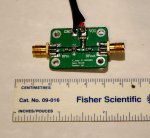This building and this little patch of earth are the only things keeping me from receiving my local tower and ground frequencies clearly. I can hear them, but they're way down in the noise. It only opens the squelch occasionally, so even the carrier is weak.
Most of my experience is as a ham, as such, I see preamplification as a tool to be used with caution. In the ham world, my goal is to lower the noise floor as much as possible. I want my S-meter reading close to zero when no signal is present. I use my HF radio's attenuation way more frequently than I use it's preamplification. But this is in regards to HF. In the VHF/UHF world, all of the popular local repeaters are on absurdly tall towers, I can get into them with full quieting using a 1 watt handheld in my basement. As a result, I know very little about VHF/UHF preamplification. Logically and unfortunately, height is almost an enemy for airport transmitters. They want Signals aiming slightly upward toward the horizon, with coverage only in their area of concern... they don't care about ground coverage.
Would this situation benefit from a preamp after the filter, perhaps with a variable attenuator? If so, what preamp might you suggest? (Bonus points if it uses N connectors.)
Note: This line accounts for both the height of the airport's transmit antennas and my receive antenna.

Most of my experience is as a ham, as such, I see preamplification as a tool to be used with caution. In the ham world, my goal is to lower the noise floor as much as possible. I want my S-meter reading close to zero when no signal is present. I use my HF radio's attenuation way more frequently than I use it's preamplification. But this is in regards to HF. In the VHF/UHF world, all of the popular local repeaters are on absurdly tall towers, I can get into them with full quieting using a 1 watt handheld in my basement. As a result, I know very little about VHF/UHF preamplification. Logically and unfortunately, height is almost an enemy for airport transmitters. They want Signals aiming slightly upward toward the horizon, with coverage only in their area of concern... they don't care about ground coverage.
Would this situation benefit from a preamp after the filter, perhaps with a variable attenuator? If so, what preamp might you suggest? (Bonus points if it uses N connectors.)
Note: This line accounts for both the height of the airport's transmit antennas and my receive antenna.







